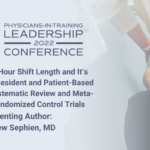Abstract | April 6, 2022
Resident Duty Hour Shift Length and It’s Association on Resident and PatientBased Outcomes: A Systematic Review and Meta-Analysis of Randomized Control Trials
Learning Objectives
- Discuss the available literature on resident duty hour restrictions;
- Understand the pooled results on the impact of resident duty hours on patient and resident-based outcomes.
Background: Resident duty hours are constantly being evaluated by the Accreditation Council for Graduate Medical Education. Multiple randomized controlled trials (RCTs) have assessed the impact of resident duty hour shift lengths on patient and resident-based outcomes. However, the results from these RCTs are a mixed bag. Therefore, we conducted a systematic review and meta-analysis of RCTs to synthesize the evidence associated with resident duty hour shift length restrictions and its impact on patient and resident-based outcomes.
Methods: A systematic search of Cochrane Library, EMBASE, and PubMed from inception until July 31, 2020, was performed. All RCTs assessing different resident shift lengths and its impact on patient and resident outcomes were eligible for inclusion. Data was extracted on participants, interventions, comparison, and outcomes. Patient outcomes included hospital length of stay, serious medical errors, and preventable adverse events. Resident outcomes included emotional exhaustion, depersonalization, personal accomplishment, resident dissatisfaction with overall well-being, sleep duration, sleepiness, and vigilance. Data was pooled under a random effects model and summarized as odds ratio (OR)/standardized mean difference (SMD) along with 95% confidence intervals (CI).
Results: Of the 873 references, nine RCTs met the inclusion criteria. There was a significant association between shorter shift length and less emotional exhaustion (SMD = -0.11, 95% CI =-0.21, -0.00) and less dissatisfaction with overall well-being (OR = 0.61, 95% CI 0.38, 0.99). There were no significant associations between shift length and hospital length of stay (SMD= 0.01, 95% CI -0.02, 0.05) and serious medical errors per 1,000 patient hours (OR= 0.76, 95% CI 0.29,2.0).
Conclusion: Shorter resident duty hour shifts was associated with improved resident outcomes but not in patient outcomes.
References and Resources:
- Ulmer C, Miller Wolman D, Johns MME, eds. Resident Duty Hours: Enhancing Sleep, Supervision, and Safety. Washington (DC)2009.
- Education ACfGM. Common program requirements — effective: July 1, 2011.
- Education ACfGM. Common program requirements — effective: July 1, 2017.
- Bilimoria KY, Chung JW, Hedges LV, et al. National Cluster-Randomized Trial of Duty-Hour Flexibility in Surgical Training. N Engl J Med 2016;374:713-27.
- Landrigan CP, Rahman SA, Sullivan JP, et al. Effect on Patient Safety of a Resident Physician Schedule without 24-Hour Shifts. N Engl J Med 2020;382:2514-23.
- Reed DA, Fletcher KE, Arora VM. Systematic review: association of shift length, protected sleep time, and night float with patient care, residents’ health, and education. Ann Intern Med 2010;153:829- 42.

